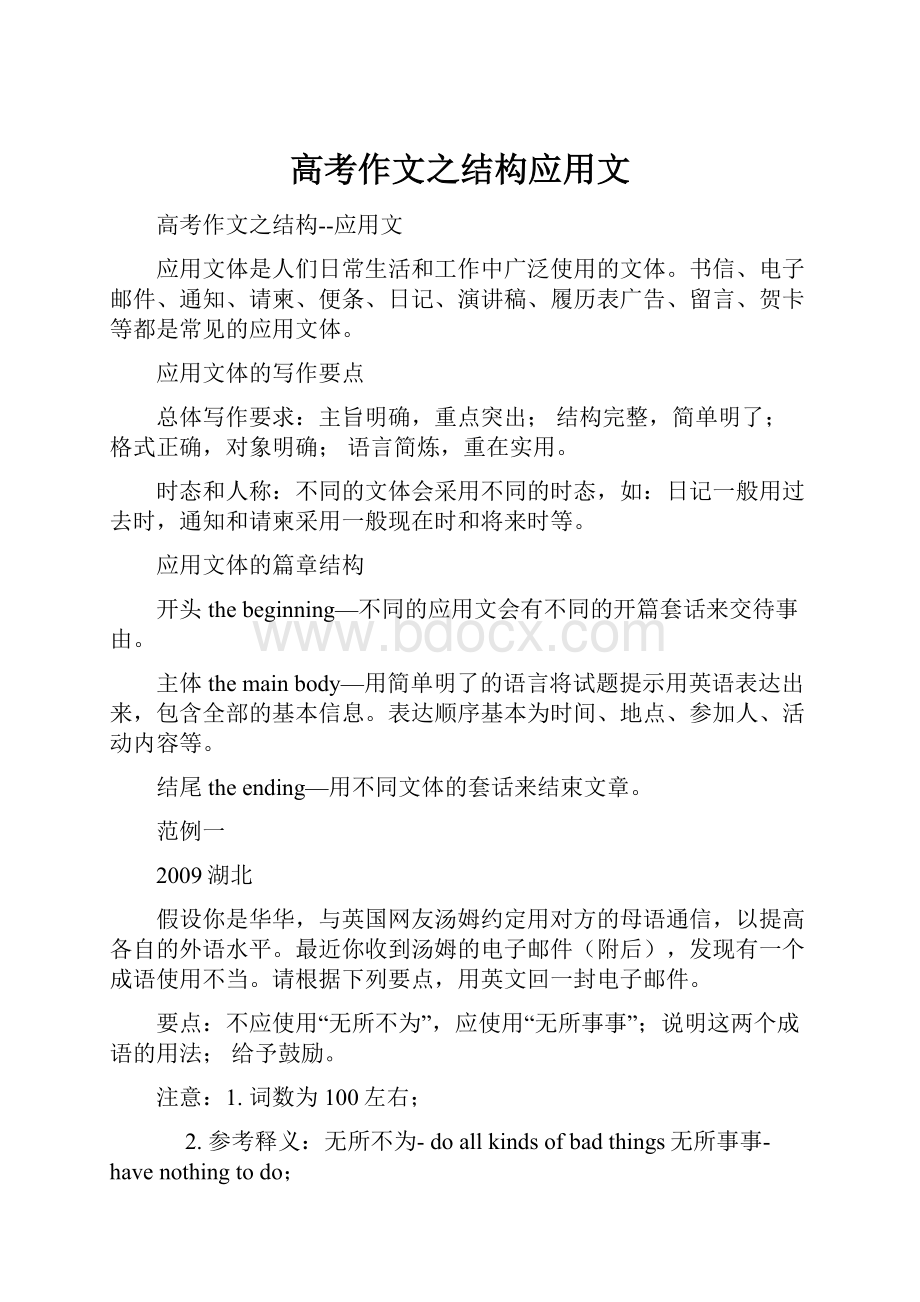高考作文之结构应用文.docx
《高考作文之结构应用文.docx》由会员分享,可在线阅读,更多相关《高考作文之结构应用文.docx(18页珍藏版)》请在冰豆网上搜索。

高考作文之结构应用文
高考作文之结构--应用文
应用文体是人们日常生活和工作中广泛使用的文体。
书信、电子邮件、通知、请柬、便条、日记、演讲稿、履历表广告、留言、贺卡等都是常见的应用文体。
应用文体的写作要点
总体写作要求:
主旨明确,重点突出;结构完整,简单明了;格式正确,对象明确;语言简炼,重在实用。
时态和人称:
不同的文体会采用不同的时态,如:
日记一般用过去时,通知和请柬采用一般现在时和将来时等。
应用文体的篇章结构
开头thebeginning—不同的应用文会有不同的开篇套话来交待事由。
主体themainbody—用简单明了的语言将试题提示用英语表达出来,包含全部的基本信息。
表达顺序基本为时间、地点、参加人、活动内容等。
结尾theending—用不同文体的套话来结束文章。
范例一
2009湖北
假设你是华华,与英国网友汤姆约定用对方的母语通信,以提高各自的外语水平。
最近你收到汤姆的电子邮件(附后),发现有一个成语使用不当。
请根据下列要点,用英文回一封电子邮件。
要点:
不应使用“无所不为”,应使用“无所事事”;说明这两个成语的用法;给予鼓励。
注意:
1.词数为100左右;
2.参考释义:
无所不为-doallkindsofbadthings无所事事-havenothingtodo;
3.除以上两个语外,邮件中不得使用其他汉字或拼音;
4.电子邮件的开头和结尾已为你写好(不计入你所写词数),但不得抄入答题卡。
附(汤姆的邮件):
华华,你好!
近几天在忙什么事?
有什么有意思的事吗?
我们的学校放假了,所以这几天在家无所不为,饱食终日,只好上网发伊妹儿。
没意思。
我决定找份工作,做个自食其力的人。
祝好!
汤姆
(以下所给内容不得抄入答题卡)
Hi!
Tom,
Nicetoreadyoure-mailtoday.Inoticeyou'vebeguntouseChineseidiomsandusedmostofthemcorrectly.
Hopeyou'llfindajobsoon.
Huahua
OnePossibleVersion:
Hi!
Tom,
Nicetoreadyoure-mailtoday.Inoticeyou'vebeguntouseChineseidiomsandusedmostofthemcorrectly.
However,I'mafraidthereisonemistakeI'dliketopointout.Itis"无所不为".Thisidiommeans"doallkindsofbadthings".Areyoudoingallkindsofbadthingsathome?
Iguesswhatyouwerereallytryingtosayisthatyou'vegotnothingtodothesedays.Inthatcase,youshoulduse"无所事事".Weusuallyuse"无所不为"toexpresstheideathatpeopledaretodoanythingbad,and"无所事事"todescribethesituationinwhichpeoplehavegotnothingmeaningfultodo.HaveImademyselfclear?
Anyway,I'mamazedattheprogressyou'vemade.
Hopeyou'llfindajobsoon.
Huahua
范例二
2009全国1
书面表达(满分25分)
假定你是李华,正在英国接受英语培训,住在一户英国人家里。
今天你的房东Mrs.Wilson不在家,你准备外出,请给Mrs.Wilson写一留言条,
内容包括:
1.外出购物;
2.替房东还书;
3.Tracy来电话留言:
1)咖啡屋(BoltonCoffee)见面取消;2)此事已告知Susan;3)尽快回电
注意:
1.词数100左右;2.可以适当增加细节,以使行文连贯。
OnePossibleVersion:
Mrs.Wilson,
I'mgoingoutshopping,andwon'tbebackuntilabout5:
00pm.IhavetakenwithmethetwobooksyouaskedmetoreturntotheCityLibrary.Atabout 1o'clockthisafternoon,Tracycalled,sayingthatshecouldn'tmeetyouatBoltonCoffeetomorrowmorningasshehassomethingimportanttoattendto.Shefeltverysorryaboutthat,butsaidthatyoucouldsetsomeothertimeforthemeeting.Shewantedyoutocallherbackassoonasyouarehome.ShehasalreadytoldSusanaboutthischange.
LiHua
附录--应用文格式套话
书信
书写格式
1.信头:
写在信纸第一页的右上角,包括写信人的地址和写信的日期。
应先写地址再写日期,且地址是先小后大。
2.信内地址:
用于公文信函,私人信函不写信内地址。
写在信纸第一页的左上角,顶格写,比信头低一至两行。
包括收信人姓名、地址。
3.称呼:
指对收信人的称呼,写在左上角顶格写;称呼后面的标点一般用逗号。
4.正文:
是信件的主体部分。
写在称呼的下一行,一般由左边第3或第5个字母处开始写起。
正文第一段也可定格写,但以后各段应空两格。
5.结束语:
指正文下面的结尾客套语。
位置应低于正文一、二行。
一般从信纸的中间稍右写起,第一个字母大写,末尾用逗号。
常用的结束语Yourssincerely,Yours,Sincerelyyours等。
6.署名:
写在结束语的下面。
注:
邀请信、感谢信和便(假)条的书写格式与书信大致相同,但信头更简便些。
写作要点
信的开头可简单嘘寒问暖,也可根据情况先提及来信内容,再步入正题。
考虑书信的交际功能,行文应感情真挚,让收信者感到自然、亲切。
结束时要向收信者表示亲切或诚挚的问候。
经典必会
【UsefulSentences】
普通书信开头用语
Iwassopleasedtohearfromyouagain.Youwanttoknowwhatisgoingon…
Manythanksforyourlastkindletter.Inyourletter…
It'salongtimesinceIsawyoulasttime.AreyouallOK?
I'mgladtoreceiveyourletter.
Ihavebeenmissingyoualotsincewemetlasttime.
Iamsorryfornotwritingtoyousooner./I'msorryI'vetakensolongtoansweryourlastletter.
I'mwritingtotellyouthat…/I'mwritingtoyouinformingthat…
结尾用语
Goodluck/Bestwishes!
Takegoodcareofyourself.
Sendmyloveto…/Pleasegivemyregards(bestwishes)to…
Dowritetouswhenyouhavetime.
Lookforwardtohearingfromyousoon.
应聘求职信开头用语
I'mastudentfrom…I'mgladtolearnthatyouneeda(an)…I'mquiteinterestedinitandIthinkIamfitforit.
结尾用语
IfIhaveachancetoworkinyourcompany,Iwilltrymybesttobeagoodemployer.
道歉信开头用语
I'mwritingtomakeanapologyfor…I'msosorrytotellyouthatI…
结尾用语
Iwonderifitispossibleto…andifso,…Idohopethatyou’llforgiveme.
感谢信
Thankyouforthemanygoodthingsyouprovided.
Thankyoufor…
邀请信开头用语
We’replanningtohold…in…on….I'mwritingtoaskyoutocomeand…
结尾用语
Doyouthink…?
Pleaseletmeknowassoonaspossiblesothatwecanmakearrangements.Lookingforwardtoyourcoming/earlyreply.
就有关社会问题讨论的书信开头用语
I'mwritingtotellyouaboutthediscussion(survey)wehavehad(made)aboutwhether…shouldbe…
结尾用语
To…ornotisaseriousproblem,whichneedsafurtherdiscussion(survey)andisdecidedbythepublic.
告知活动的书信开头用语
…willbeheldin…on…
Thereisgoingtobein…
Iknowyoulike…Ithinkitisagoodchanceforyouto…
结尾用语
IfthereisanythingIcandoforyou,pleaseinformme.Iwouldbemorethangladtohelp.
表述观点的书信开头用语
I'mverygladtohavereceivedtheletteryousentme.I'vebeenthinkingaboutthequestionyouaskedme.Inmyopinion,youshould…
结尾用语
Therefore,Ithinkitisagoodideaforyouto…Sowhatyouarewaitingfor?
寻求帮助的书信开头用语
Ihaveaproblemtoaskyou.
结尾用语
I'mtroubled/puzzled/disappointed/ataloss.WhatshouldIdo?
Iwonderhowyoucouldtreatitifyouwereme.
告知来访路线的书信
We'resogladtolearnthatyouarecomingtojoinusin…Hereishowyoucanfindus.I’msureyou’llhavenotroublefindingus.Docome!
Don’tmissit!
经典范例
(2006重庆)加拿大高中生David在互联网(Internet)上登出启事(notice),希望结识一位中国朋友,以便学习中国的语言、文化(culture)。
假设你是李华,请在看到这则启事后,用英文给David发一封电子邮件,主要内容包括:
1.你怎样得知David的愿望;2.你愿意成为他的朋友;
3.你打算如何帮助他;4.你盼望他的回复。
注意:
词数100左右。
OnePossibleVersion:
DearDavid,
I'mLiHua,aChinesestudentwiththesameageasyou.
WhilesurfingtheInternet,Ihappenedtoseeyournotice,fromwhichIknewyouwereeagertohaveaChinesefriend.IamgladtotellyouthatIamtheverypersonyouarewaiting.
I'mreallyhappytobeofsomehelpwithyourChinesestudy.Wecane-mailtoeachothertotalkaboutyourproblemsandwehadbettercommunicateinsimpleChinese.AlsowecanbothwriteandtalktoeachotherontheSkype,aprogramthatcancarrysoundsaswellaswords.IwillcollectandsendsomepicturesandarticlesaboutChineseculturetoyou.Dobeconfidentanddon'tbeafraidofmakingmistakes,foryouknowitisn'teasytolearnanyforeignlanguage.
Lookingforwardtoyou
Yours,
LiHua
日记写作要点
英语日记与汉语日记的结构相似,主要由两部分组成,即书端和正文。
写日记要注意以下几点:
1.日记的第一行要写清楚日期、星期和天气状况,日期和星期写在正文的左上角,月份与星期可以缩写;天气状况写在正文的右上角。
如果是游记,还可写明地点。
2.日记通常使用过去时态记述过去所发生的事情。
当发表议论、抒发情感或描写景物、人物时,为了使表述更加生动,也可用一般现在时。
3.日记正文可以是叙事、描述、说明、议论等各种形式,并且应用第一人称来写。
4.日记也应该讲究文采,切忌写成流水账。
经典必会
【UsefulWords&Expressions】
1.表示天气:
fine,rainy,cloudy,snowy,windy,foggy,wind,breeze…
2.表示星期:
Sunday,Monday,Tuesday,Wednesday,Thursday,Friday,Saturday
3.表示月份:
January,February,March,April,May,June,July…
4.表示具体日期:
thefirst(1st),thesecond(2nd),thethird(3rd)…
【UsefulSentences】
1.Itis/wasafine/niceday.天气晴朗。
2.Thereare/weremanythingstodoandsee.有很多东西可看,有很多事情可做。
3. Ihadagoodtime/enjoyedmyselftoday.我今天玩得很高兴。
4.Iwillneverforgetitforever.我将永远不会忘记这件事。
5.Timeflieslikeanarrow.IntendaysitwillbetheNewYear.光阴似箭。
再过10天就是新年了。
6.Autumnisaseasonofharvest.秋天是收获的季节。
7.Itisgettingwarmerandwarmer.天气变得越来越暖和了。
经典范例用日记形式记一次有意义的旅行。
提示:
1.时间:
2000年4月16日,星期天;2.天气:
晴;
3.人员:
你班全体人员;4.地点:
森林(乘车两小时到达);
5.活动内容:
记录看到的动植物,野餐,检验河水,看看是否有污染。
要求:
词数不少于100词。
OnePossibleVersion:
Sunday,April16, Fine2000
Todayourclassorganizedtriptoaforest.Wewentbybusandittookustwohourstogettotheforest.Whenwearrived,wewalked throughtheforestseparately.Wewererecordedallthewildlifeandplantswecouldseeintheforestaswewalked.Whenwefoundanunknownplant,wewroteitdowninournotebooks.
Atlunchtimewemadeafireintheopenandcookedthemealoverit.Afterlunch,wecametoariverandtestedthewatertoseeifitwaspolluted.Lateintheafternoonwereturned.Toourjoy,wenotonlylearnedaboutsomewildlifeandplants,butalsoenjoyedourselvesverymuch.IhopeI'llhaveanotherchancetogooutforamoreinterestingouting.
便条英语便条主要是指留言条(Messageleft)和请假条(WrittenRequestforLeave)等。
英语便条一般由日期、称呼、正文和署名四部分组成。
1.日期:
日期要写在右上角,通常只需写星期几或星期几的上午、下午,有时可只写上午或下午及具体时间,不必写出年份。
(有时候也可以不写)
2.称呼:
称呼一般写在第二行,要左起顶格写。
语气视对象而定,朋友间可随便一些,如DearTom,Tom,XiaoGao等。
3.正文:
正文要另起一行,用词要通俗简明,只要把事情说清楚就行。
若有事请假或向别人借东西,语言要委婉、客气。
4.署名:
位置在正文的右下角。
写留条人的姓名、姓或名均可。
经典必会
【UsefulWords&Expressions】
1.表示时间:
rightaway/now,atonce,inamoment/minute,justnow,threehourslater/ago,tomorrowmorning,nextweek,immediately…
2.表示邀请:
meetat8:
00outsidetheschoolgate,invite…to…,comeover,welcometo…,askfor…,wouldlike…
3.表示请假:
givesb.aday'sleave,havethreedaysoff,askforsickleaveoftwoweeks…
4.表示叮嘱:
make/besure,remember,don'tforget…,takeamessagefor,give…acall/ring,ring…up,tell…to,take/bring…
5.表示事由:
beill,have/take/catchacold/cough/headache…,haveasoreback…
【UsefulSentences】
1.I’msorrythatIcan'tgotoschooltoday.很遗憾我今天不能去上学了。
2.Ishallbeveryhappytocallatyourhouseat8:
30thisevening.很高兴我今晚8:
30能去你家拜访。
3.Iaminurgentneedof500yuan.我急需500元钱。
4.Pleasegivemealeaveforfivedays.请准我5天假。
5.Ihavereceivedyournote.来条收悉。
6.Pleaseacceptthislittlegift.请收下这小小的礼物。
7.Pleasefavormewithanearlyreply.请尽早回复。
8.Would/Could/Willyouplease…?
请你……好吗?
经典范例
假设你叫李华,到同学李英家通知她一件事,碰巧她不在家,你给她留了张便条,内容如下:
1.明天的课将推迟到本星期六下午2点,因为明天你要参加劳动—植树,上午7点在校门口集合出发。
2.前天你把雨伞落在她家房子的前门外,请她明天上课时替你带来。
LiHua
8.10
Onepossibleversion: